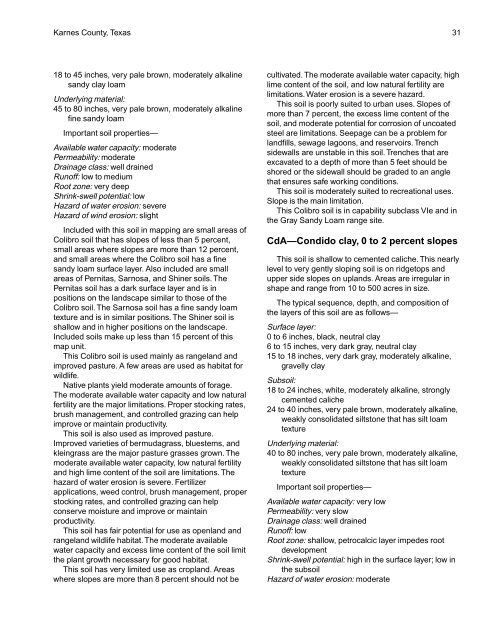Soil Survey of Karnes County, Texas - Soil Data Mart - US ...
Soil Survey of Karnes County, Texas - Soil Data Mart - US ...
Soil Survey of Karnes County, Texas - Soil Data Mart - US ...
Create successful ePaper yourself
Turn your PDF publications into a flip-book with our unique Google optimized e-Paper software.
<strong>Karnes</strong> <strong>County</strong>, <strong>Texas</strong> 31<br />
18 to 45 inches, very pale brown, moderately alkaline<br />
sandy clay loam<br />
Underlying material:<br />
45 to 80 inches, very pale brown, moderately alkaline<br />
fine sandy loam<br />
Important soil properties—<br />
Available water capacity: moderate<br />
Permeability: moderate<br />
Drainage class: well drained<br />
Run<strong>of</strong>f: low to medium<br />
Root zone: very deep<br />
Shrink-swell potential: low<br />
Hazard <strong>of</strong> water erosion: severe<br />
Hazard <strong>of</strong> wind erosion: slight<br />
Included with this soil in mapping are small areas <strong>of</strong><br />
Colibro soil that has slopes <strong>of</strong> less than 5 percent,<br />
small areas where slopes are more than 12 percent,<br />
and small areas where the Colibro soil has a fine<br />
sandy loam surface layer. Also included are small<br />
areas <strong>of</strong> Pernitas, Sarnosa, and Shiner soils. The<br />
Pernitas soil has a dark surface layer and is in<br />
positions on the landscape similar to those <strong>of</strong> the<br />
Colibro soil. The Sarnosa soil has a fine sandy loam<br />
texture and is in similar positions. The Shiner soil is<br />
shallow and in higher positions on the landscape.<br />
Included soils make up less than 15 percent <strong>of</strong> this<br />
map unit.<br />
This Colibro soil is used mainly as rangeland and<br />
improved pasture. A few areas are used as habitat for<br />
wildlife.<br />
Native plants yield moderate amounts <strong>of</strong> forage.<br />
The moderate available water capacity and low natural<br />
fertility are the major limitations. Proper stocking rates,<br />
brush management, and controlled grazing can help<br />
improve or maintain productivity.<br />
This soil is also used as improved pasture.<br />
Improved varieties <strong>of</strong> bermudagrass, bluestems, and<br />
kleingrass are the major pasture grasses grown. The<br />
moderate available water capacity, low natural fertility<br />
and high lime content <strong>of</strong> the soil are limitations. The<br />
hazard <strong>of</strong> water erosion is severe. Fertilizer<br />
applications, weed control, brush management, proper<br />
stocking rates, and controlled grazing can help<br />
conserve moisture and improve or maintain<br />
productivity.<br />
This soil has fair potential for use as openland and<br />
rangeland wildlife habitat. The moderate available<br />
water capacity and excess lime content <strong>of</strong> the soil limit<br />
the plant growth necessary for good habitat.<br />
This soil has very limited use as cropland. Areas<br />
where slopes are more than 8 percent should not be<br />
cultivated. The moderate available water capacity, high<br />
lime content <strong>of</strong> the soil, and low natural fertility are<br />
limitations. Water erosion is a severe hazard.<br />
This soil is poorly suited to urban uses. Slopes <strong>of</strong><br />
more than 7 percent, the excess lime content <strong>of</strong> the<br />
soil, and moderate potential for corrosion <strong>of</strong> uncoated<br />
steel are limitations. Seepage can be a problem for<br />
landfills, sewage lagoons, and reservoirs. Trench<br />
sidewalls are unstable in this soil. Trenches that are<br />
excavated to a depth <strong>of</strong> more than 5 feet should be<br />
shored or the sidewall should be graded to an angle<br />
that ensures safe working conditions.<br />
This soil is moderately suited to recreational uses.<br />
Slope is the main limitation.<br />
This Colibro soil is in capability subclass VIe and in<br />
the Gray Sandy Loam range site.<br />
CdA—Condido clay, 0 to 2 percent slopes<br />
This soil is shallow to cemented caliche. This nearly<br />
level to very gently sloping soil is on ridgetops and<br />
upper side slopes on uplands. Areas are irregular in<br />
shape and range from 10 to 500 acres in size.<br />
The typical sequence, depth, and composition <strong>of</strong><br />
the layers <strong>of</strong> this soil are as follows—<br />
Surface layer:<br />
0 to 6 inches, black, neutral clay<br />
6 to 15 inches, very dark gray, neutral clay<br />
15 to 18 inches, very dark gray, moderately alkaline,<br />
gravelly clay<br />
Subsoil:<br />
18 to 24 inches, white, moderately alkaline, strongly<br />
cemented caliche<br />
24 to 40 inches, very pale brown, moderately alkaline,<br />
weakly consolidated siltstone that has silt loam<br />
texture<br />
Underlying material:<br />
40 to 80 inches, very pale brown, moderately alkaline,<br />
weakly consolidated siltstone that has silt loam<br />
texture<br />
Important soil properties—<br />
Available water capacity: very low<br />
Permeability: very slow<br />
Drainage class: well drained<br />
Run<strong>of</strong>f: low<br />
Root zone: shallow, petrocalcic layer impedes root<br />
development<br />
Shrink-swell potential: high in the surface layer; low in<br />
the subsoil<br />
Hazard <strong>of</strong> water erosion: moderate
















